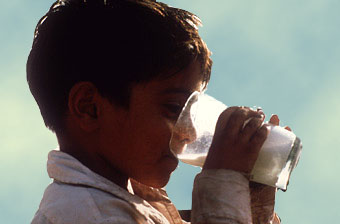NMPF Applauds U.S. Government Effort to Improve WHO Proposal on Child Nutrition
June 5, 2016

NMPF and allies in the dairy community around the world were successful in moderating the potentially harmful impact of a World Health Organization child nutrition guidance document that came before the World Health Assembly in Geneva, Switzerland, last month.
Although the intent of the guidance document was to promote breastfeeding and young child nutrition, goals NMPF strongly supports, the proposal as drafted went dangerously overboard in suggesting sweeping restrictions that could have been interpreted to discourage milk and milk product consumption by toddlers up to age 3. In addition to being harmfully unclear and broadly worded, the guidance document’s scientific basis was sorely lacking.
Over the course of several months, NMPF reached out to the Obama Administration and Congress, urging them to address the concerns posed by the ill-advised guidance document drafted by WHO staff. These efforts included numerous discussions and meetings with various federal agencies, including the Departments of Health & Human Services and Agriculture, the Office of the U.S. Trade Representative, and the White House.
NMPF President Jim Mulhern sent a letter to the President last month, together with the leaders of the U.S. Dairy Export Council and the International Dairy Foods Association, which underscored the seriousness of the issue. Leading congressional dairy supporters, who shared NMPF’s concerns, voiced similar concerns to high-ranking officials throughout the Administration as part of this effort. Those dairy champions included House Speaker Paul Ryan, Senate Finance Chairman Orrin Hatch, Senate Finance Ranking Member Ron Wyden, Ways & Means Chairman Kevin Brady, and Representatives Ron Kind, Pat Tiberi, Peter Welch, David Valadao, and Devin Nunes, among others.
The U.S. government agreed with NMPF’s view that global public health policy must continue to reflect the important role dairy plays in child nutrition and U.S. statements at the concluding World Health Assembly meeting reflected that. This was an important reaffirmation because, as written, the WHO guidance on foods for young children could have been interpreted in ways that resulted in new marketing limits on milk and other dairy products.
“Thanks to the efforts of the U.S. government and NMPF we’ve ensured that the WHA resolution on this guidance incorporates well-established nutrition principles that stress the importance of consumption of nutrient-rich dairy products by toddlers both here and abroad," said NMPF President and CEO Jim Mulhern.
At the World Health Assembly (WHA) in late May, the U.S. played the lead role in shaping an important WHA resolution on the original WHO guidance document. The U.S. fought hard to ensure that the resolution provided important context around how countries should implement the guidance document. The U.S. focus was driven by an effort to ensure that child nutrition, not ideology, was the key driver in all decisions. NMPF’s work with the U.S. government, and their leadership at the WHA, achieved 4 beneficial results:
- Emphasized the continued importance of existing WHO & FAO dietary guidelines, which encourage dairy consumption;
- Ensured that any adoption of the guidance document take into account existing nutrition legislation and policies (which in the U.S. strongly encourage dairy consumption by young children) and international obligations (which prevent countries from unduly restricting trade);
- Provided an avenue for evaluating experiences with the guidance in order to examine its effectiveness and consider changes; and
- Upheld the independence of the Codex Alimentarius Commission as the appropriate standard-setting body for food products.
The U.S. statement at the WHA was unequivocal in stressing the benefits dairy consumption can have for child health and good nutrition. Specifically, the U.S. statement at the WHA highlighted that “children over six months of age need nutrient-rich complementary foods from a variety of sources. This can include dairy products such as milk, cheese and yogurt…This Guidance does not intend to discourage their inclusion in the diets of young children.” The U.S. press statement similarly highlighted dairy’s benefits by noting that dairy has been an important part of the Dietary Guidelines for Americans since the first edition was published in 1980.
NMPF will continue to work with the Administration and congressional allies to ensure that the critical contextual framework provided by the WHA resolution on this issue carries forward as the U.S. monitors how other trading partners are implementing the recommendations.

 Download PDF
Download PDF



